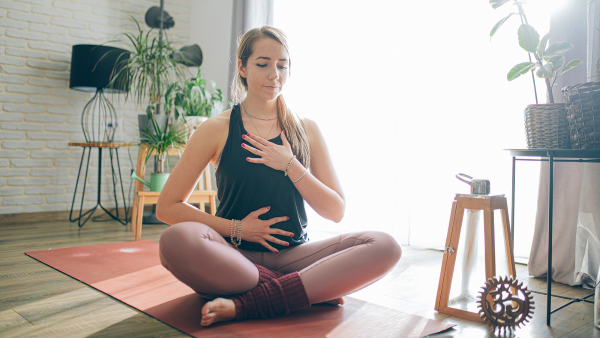Yoga, an ancient practice from India, integrates physical postures, breath control, and meditation to enhance overall well-being. Ujjayi Pranayama, also known as Victorious Breath or Ocean Breath in English, is a distinctive breathing technique that promotes calmness, concentration, and vitality. This article provides an in-depth look at Ujjayi Pranayama, covering its history, practice steps, health benefits, and precautions.
What is Ujjayi Pranayama?
Ujjayi Pranayama, or Victorious Breath, is a pranayama technique characterized by a soft, whispering sound produced during inhalation and exhalation. This sound is reminiscent of ocean waves, which is why it is also called Ocean Breath. The name “Ujjayi” comes from the Sanskrit words “uj” (to rise) and “jayi” (to conquer), indicating its empowering and elevating effects.
Also, watch web stories: What is pranayama, one of the yogic practices, used for?
A Brief History of Ujjayi Pranayama
Ujjayi Pranayama has its roots in ancient yogic traditions and is mentioned in classical texts such as the “Hatha Yoga Pradipika” and the “Yoga Sutras of Patanjali.” Historically, it has been used by yogis to enhance their practice and meditation by promoting deep relaxation and mental focus. Its soothing and balancing effects have made it a fundamental practice in various yoga systems.
How to Do Ujjayi Pranayama: Step-by-Step Instructions
Performing Ujjayi Pranayama involves a series of steps focusing on controlled, audible breathing:
- Preparation:
- Sit comfortably in a cross-legged position such as Sukhasana (Easy Pose) or Padmasana (Lotus Pose).
- Keep your spine straight, shoulders relaxed, and hands resting on your knees. Close your eyes and take a few deep breaths to settle into the practice.
- Creating the Sound:
- Slightly constrict the back of your throat (glottis) as you inhale and exhale through your nose. This constriction creates a soft, whispering sound similar to the ocean waves or a gentle snore.
- Ensure the breath is smooth and continuous, with no jerky movements.
- Starting the Breath:
- Inhale deeply through your nose, filling your lungs while maintaining throat constriction.
- Exhale slowly through your nose, keeping the throat constriction and producing the same soft sound.
- Continue the Cycle:
- Continue this cycle of controlled inhalation and exhalation, focusing on the sound and sensation of the breath.
- Practice for 5-15 minutes, maintaining a steady rhythm and deep, full breaths.
Health Benefits of Ujjayi Pranayama
Ujjayi Pranayama offers numerous health benefits, including:
- Reduces Stress and Anxiety:
- Calms the mind and reduces stress and anxiety by promoting relaxation. (Source)
- Improves Concentration and Mental Clarity:
- Enhances focus, concentration, and mental clarity through mindful breathing. (Source)
- Regulates Blood Pressure:
- Helps balance blood pressure by calming the nervous system. (Source)
- Enhances Respiratory Function:
- Improves lung capacity and efficiency by promoting deep, controlled breathing. (Source)
- Increases Energy and Vitality:
- Boosts energy levels and vitality by oxygenating the body and mind. (Source)
Who Should Do Ujjayi Pranayama
It is beneficial for:
- Individuals seeking to reduce stress and promote relaxation.
- Those looking to improve concentration, focus, and mental clarity.
- People aim to balance their blood pressure and calm the nervous system.
- Practitioners want to enhance respiratory health and lung function.
- Individuals seeking to increase energy and vitality.
Also, read: Quickly Know All About Brahmari Pranayama – Humming Bee Breath
Who Should Not Do Ujjayi Pranayama
It is generally safe for most people, but it may not be suitable for:
- Individuals with severe respiratory conditions or nasal blockages.
- Those with high blood pressure or heart conditions without professional guidance.
- People experience dizziness or fainting during practice.
Precautions to Take
- Practice Ujjayi Pranayama on an empty stomach or at least 2-3 hours after a meal.
- Maintain a slow, steady, and comfortable breathing pace.
- Avoid straining or forcing the breath; the practice should be gentle and soothing.
- Consult with a healthcare provider or experienced yoga instructor if you have any underlying health conditions.
- If you feel dizzy or uncomfortable, stop the practice and return to normal breathing.
References and Sources
In conclusion, It is a powerful and effective pranayama technique that offers extensive physical and mental benefits. By understanding its history, learning the proper technique, and adhering to precautions, you can safely incorporate Ujjayi Pranayama into your yoga practice to enhance your overall well-being.





